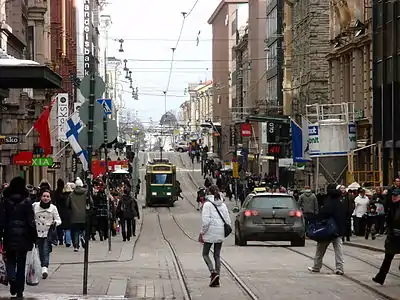Aleksanterinkatu
Aleksanterinkatu (Swedish: Alexandersgatan) is a street in Kluuvi, the commercial centre of Helsinki, Finland. In the city plan by Carl Ludvig Engel, it was the Decumanus Maximus, the main east–west street in the city, crossing the Cardo, Unioninkatu (Union Street) at the corner of the Senate Square.

The street begins near the Presidential Palace and continues to meet with Mannerheimintie, the longest street in Helsinki. It runs past several famous buildings, such as Ritarihuone (the seat of Finnish nobility), the Helsinki Cathedral, the Finnish main office of the Nordea bank, the main building of the University of Helsinki, and the Stockmann department store.
The street, colloquially known in Helsinki as "Aleksi", was named for Emperor Alexander I of Russia in 1833. It was originally named Suurkatu (Swedish: Storgatan), meaning "Grand Street", but was renamed after the Emperor's death in his honour. The streets crossing Aleksanterinkatu are named after the Emperor's mother, his brothers, and his sisters.

At Christmas time, Aleksanterinkatu is traditionally decorated with elaborate Christmas lights.
The tram lines 2, 3, 4, 4T, 7A and 7B run along Aleksanterinkatu. Of these, only 4 and 4T run along the street's entire length.
Aleksanterinkatu is also the name of the main street in many other Finnish cities, e.g.: Tampere, Lahti, Oulu, Porvoo and Loviisa.